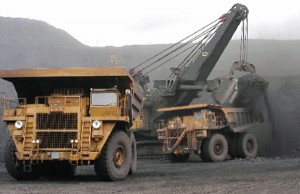Home »

Environmental groups state Elk River being poisoned by coal mining

A new study indicates that the Elk River is being poisoned by selenium leaching from open-pit coal mining waste rock, states a press release issued by regional and provincial environmental groups.
Wildsight, Sierra Club BC, Canadian Parks and Wilderness Society BC and Yellowstone to Yukon Initiative stated in a March 21 press release that “high rates of selenium – far in excess of provincial guidelines – have created a crisis for fish and other species in the Elk River.”
Dr. Ric Hauer of the Flathead Lake Biological Station of the University of Montana issued a March 2 study comparing water quality in the Elk and neighbouring Flathead River Basins. Commissioned by Glacier National Park (Montana), the study found nitrogen levels at 1,000 times the background rate, sulphate levels at 40-50 times the background rate and selenium levels at seven to 10 times background rate.
The researchers tested above and below mines and used the pristine water quality of the nearby Flathead River to determine background levels and ascertain what aquatic life would normally be present in the Elk River were it not so polluted.

“The science is clear: selenium from the mines has polluted the river to levels known to be dangerous to fish,” said Wildsight Executive Director John Bergenske. “The selenium bio-accumulates and could lead to fish population collapse because it affects reproductive organs in fish. Eating them could also affect human health.”
There are currently five coal mines in the Elk River Valley, which is adjacent to the Flathead River Valley. In addition to the existing mines that are causing toxic pollution, there are four coal mine expansion proposals in the project review stage, one new coal mine proposal and three exploration projects underway, the joint release notes.
“There should be a moratorium on new coal mining in the Elk until the far-reaching impacts of existing mines are addressed,” said Sarah Cox, Interim Executive Director for Sierra Club BC. “Projects like the Line Creek coal mine expansion and proposed Bingay coal mine would only increase toxic pollution in the Elk. We need to take a big step back and look at how this area is managed as a whole.”
 Fish are not the only species affected. The pollution from the mines is killing off smaller organisms like caddis flies, a vital part of the food chain.
Fish are not the only species affected. The pollution from the mines is killing off smaller organisms like caddis flies, a vital part of the food chain.
The Hauer study states “all coal mining sites had increased nitrogen loading, increased sulfate loading, increased selenium loading, higher algal production as a result of increased nitrogen loading, and a decrease in macroinvertebrate diversity and abundance particularly of species sensitive to pollution.”
Wendy Francis, Program Director for Yellowstone to Yukon Conservation Initiative stated, “We need a comprehensive long-term plan that reconciles the region’s world-class wildlife and wilderness values with its coal resources. The plan should ensure protection of human health, wilderness recreation, international fisheries, water quality and core habitat values, as well as wildlife connectivity from the Flathead River Valley to Banff National Park.”
Peter Wood, CPAWS-BC Terrestrial Campaigns Director agrees. “These levels of selenium are toxic and known to cause deformities in fish and other species. Clearly we are far from striking the right balance between resource development and the need to maintain the health of these ecosystems.”
In closing the press release, Wildsight, Sierra Club BC, CPAWS-BC and the Yellowstone to Yukon Conservation Initiative “are urging the B.C. government to agree to a national park in the southeastern one-third of the Flathead, to fill in the missing piece of the adjacent Waterton-Glacier International Peace Park, a World Heritage Site and two UNESCO Biosphere Reserves. The groups are also calling for a Wildlife Management Area in the rest of the Flathead and adjoining habitat, which includes part of the Elk.”
The provincial government is aware of the situation stated Environment Minister Terry Lake March 21, while detailing that no new coal mines will be approved in the Elk Valley until Teck develops a valley-wide plan to manage the cumulative effects of selenium concentrations in the Elk River.

Kootenay East MLA Bill Bennett said government is aware of the situation and is working with Teck Ltd. to develop a solution.
“Government has been aware and has been working very, very hard with Teck for at least three years or four years and Teck has, to their credit, invested a lot of money and are actually producing a lot of the data that now will require them to pay a lot of money to fix this situation,” he told e-KNOW.
“The kicker here – the challenge – is going to be to have the company do what’s necessary to first of all stabilize the trend, because the trend is up. The company has to find a way to stabilize the trend so that it doesn’t go up any more. They then have to find a way to reverse the trend and get the number down to a number that Health Canada would say is appropriate,” he said, admitting he doesn’t know “for sure” what that number would be. “I think there is different opinions on that.”
Bennett also said Teck should not be considered as being completely at fault for rising selenium levels.
“The biggest part of the challenge is that coal mining has existed over there for decades and decades and decades. There’s been coal mining in the Elk Valley for over a hundred years and so Teck has inherited, through purchasing Fording Coal and the mine at Line Creek. All the rock that was dumped by those companies, really, in good faith, with people not really understanding selenium I think and now it’s their problem,” he said.
The current Minister of Community, Sport and Cultural Development said the province has to also be aware of the importance of the coal mining industry to the East Kootenay’s economy.
“Government is faced with ‘what do we do about this? We can’t allow selenium levels to continue to increase but on the other you’ve got 4,000 direct jobs, several thousand indirect jobs; the jobs in the industry average $110,000/$120,000 a year. It would absolutely cripple the economy of the East Kootenay. Even my constituents here in Cranbrook have no idea how lucky we are, from a socio-economic point of view, to have them (Teck),” he said.
Teck has been an excellent corporate citizen, Bennett said, noting many organizations in the region and social services and amenities have benefited greatly from the company’s philanthropy.
“It’s incredible what they do. We have to recognize that Teck is the kind of company that is sincere that they want to help and sincere that they are prepared to spend billions of dollars and they’ve said so. That’s a really good start to this.”
Teck told e-KNOW it has been working on a solution to selenium for several years.
“This study reconfirms the challenges that Teck has been researching and working collaboratively with stakeholders to find solutions to for years. As a result, we are taking action through our Valley-wide Selenium Management Action Plan, which is one of the largest water quality management programs of its kind in the world,” said Teck’s Senior Communications Specialist Chris Stannell.
“The plan outlines significant measures, based on extensive scientific research, to protect aquatic health while supporting sustainable mining activities in the Elk Valley. Over the next five years, Teck will invest up to $600 million on the installation of water diversion and treatment facilities, investments in research and development to improve selenium management, and ongoing aquatic monitoring. We have completed construction of several water diversions to prevent water from contacting selenium at our operations, and construction is currently underway on our first water treatment plant at our Line Creek operation,” Stannell related.
Dan Savage, communications director for the proposed Bingay Coal Mine near Elkford, said there is confidence that selenium can be managed.
“Bingay Coal is confidant that selenium can be properly managed using today’s mining science. We recognize that the Elk River is sacred and will ensure that the mine does not negatively affect watershed health. The Environmental Assessment process sets the highest selenium standards and for Bingay Coal to be approved, the mine plan must effectively mitigate all potential selenium issues.”
 Bennett pointed out that it isn’t really known how much selenium in the ground is simply natural. “We don’t know how high the selenium count was in the Elk River 30, 40 or 50 or 100 years ago.”
Bennett pointed out that it isn’t really known how much selenium in the ground is simply natural. “We don’t know how high the selenium count was in the Elk River 30, 40 or 50 or 100 years ago.”
Coal seams are porous and “that’s where the water comes from,” so it is possible that undisturbed coal seams (non-mined) may be part of the problem as well.
Bennett cautioned again that playing politics with the environment could severely damage the region’s economy.
 “I think Teck is sincere about spending the money they need to spend. They’ve said they will spend $750 million on the water treatment plant for Line Creek 2. Line Creek 2 is the new pit that they are proposing; government is going to have to make a decision on that fairly quickly. If government doesn’t – Line Creek will run out of coal and 500 people will be unemployed. That’s a fact. We’re talking in the next calendar year. So government and politicians have to recognize that. We get it. It’s a real problem but putting these guys out of business or having them shut their doors and move to South America is not a solution. And we know who is responsible for the clean up if the company just goes ‘bye.’ I’m very supportive of the company and very supportive of the Ministry of Environment. I think we’ve got a guy as Minister of Environment right now (Lake) who is as eSnvironmentally responsible as any Minister of Environment B.C. has ever had. He’s trying to find a solution and work with the company in a way that will move us in the right direction,” he said.
“I think Teck is sincere about spending the money they need to spend. They’ve said they will spend $750 million on the water treatment plant for Line Creek 2. Line Creek 2 is the new pit that they are proposing; government is going to have to make a decision on that fairly quickly. If government doesn’t – Line Creek will run out of coal and 500 people will be unemployed. That’s a fact. We’re talking in the next calendar year. So government and politicians have to recognize that. We get it. It’s a real problem but putting these guys out of business or having them shut their doors and move to South America is not a solution. And we know who is responsible for the clean up if the company just goes ‘bye.’ I’m very supportive of the company and very supportive of the Ministry of Environment. I think we’ve got a guy as Minister of Environment right now (Lake) who is as eSnvironmentally responsible as any Minister of Environment B.C. has ever had. He’s trying to find a solution and work with the company in a way that will move us in the right direction,” he said.
“I’m encouraged by the fact that Teck is saying, under today’s coal prices, we can justify this kind of investment and commitment. That’s the best we can hope for under the circumstances.”
For more information about Teck and selenium management, including the Teck Valley-wide Selenium Management Plan, go to: www.teck.com/selenium .
More information
HAUER and SEXTON Water Quality Report 2013 FINAL rs.pdf
HAUER and SEXTON Water Quality Report 2013 FINAL Appendix A-D.pdf
http://en.wikipedia.org/wiki/Selenium
Ian Cobb/e-KNOW







